Fashion for machine guns on the sides. British Mediums
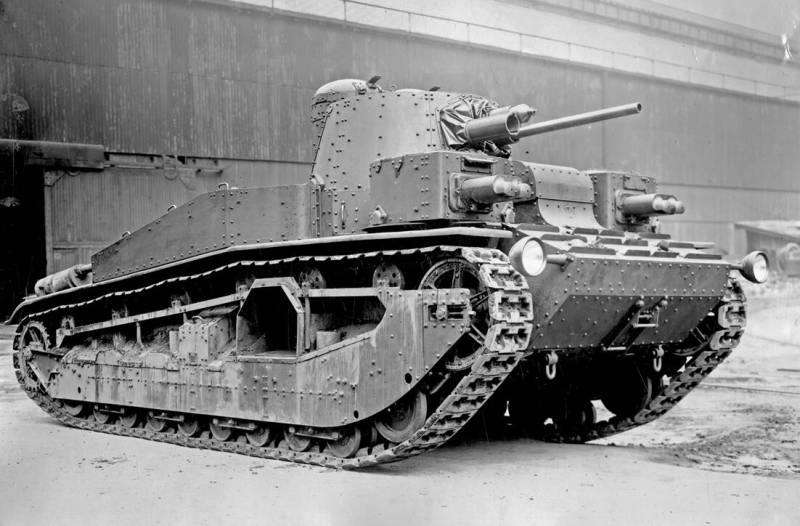
16-ton Vickers in the yard of the plant. The exceptional machine-gun power is noteworthy: five water-cooled Vickers machine guns, which, in this position of the towers, can fire forward
Tank panopticon. There are tanks and ... "Tanks". In general, they all left in stories its mark, but some, in the words of J. Orwell, were "more equal than others." British tanks of the Vickers company are also among such landmark tanks for the history of armored vehicles. Moreover, many of them never fought and were not accepted into service by the English army. But they had a chance to play their role in history, so today we will tell you about them.
Their story began in the very mid-20s, when the British army finally began to receive such new tanks as the Medium Tank Mk.I and Medium Tank Mk.II. Note that vehicles of this class first went into production and entered service, although medium tanks were in service with the British Army before that. It’s just that these machines had such an innovation as a rotating tower, which they did not have before.
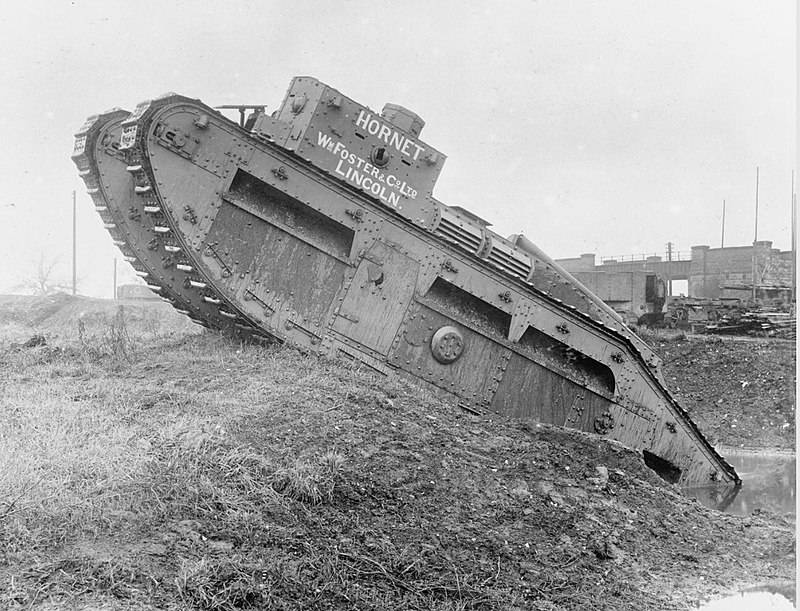
Medium tank MK. C Hornet with a cabin instead of a tower
The design turned out to be very successful, therefore, these machines served for quite some time. But the rule is this: he adopted one good tank, immediately develop the next one. So the British military and engineers already in 1926 began to look for what to replace them in the future. Here the Vickers company, the largest British manufacturer weapons, and offered the army its Medium Tank Mk.III, which can be translated as “medium brand III tank”. But fate is often a villain. Abroad, this tank gained the greatest popularity, and in England its fate was quite difficult.
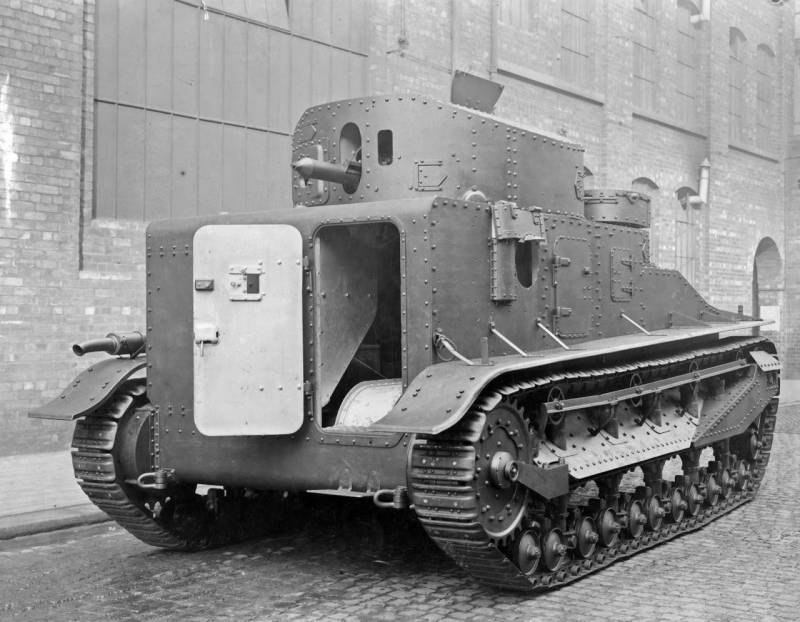
Among the advantages of the tank MK. I should include the convenience of entry and exit. The hatch on the tower, hatches on the sides, and even this door
What claims did the military have on Medium Tank Mk.I and Medium Tank Mk.II vehicles? First of all, to the front of the engine. The driver had to be planted in a tall booth, which made it difficult to fire from the turret while lowering the gun barrel. At that time, their speed of 24 km / h seemed to be sufficient, but the military wanted more. After all, a tank is never too fast. Well, and thin armor. These tanks were sent to India for service at all with only machine gun weapons. It seemed to be enough, since the armor of the "mediums" held all the bullets of the then rifles. But not shells!
But the technical specification for the new car was based on the 1922 specification ... for a heavy tank. It required the engine to be installed at the rear. Provide the tank with the ability to overcome trenches at least 2,8 meters wide. Armament - 3-pound (47-mm) gun in the bow and 2 more machine guns in sponsons. That is a complete archaic. But the Vickers company quickly redesigned the project, so now the gun was installed in the tower. Machine guns were also installed in the towers, and a car came out known as the A1E1 Independent. This tank, as you know, was built, tested, but because of the high cost "did not go." Although he was in military service. During World War II, he was dug into the ground in the area of the alleged German landing and turned into a pillbox.
By the way, the fashion for machine guns on the sides had its roots. It was believed that the tank would call into the trench, and pour fire on them from these machine guns. This was speculatively not bad, although even then it was already known that nobody was digging trenches in a straight line. All instructions indicated that they should be laid in a zigzag pattern!
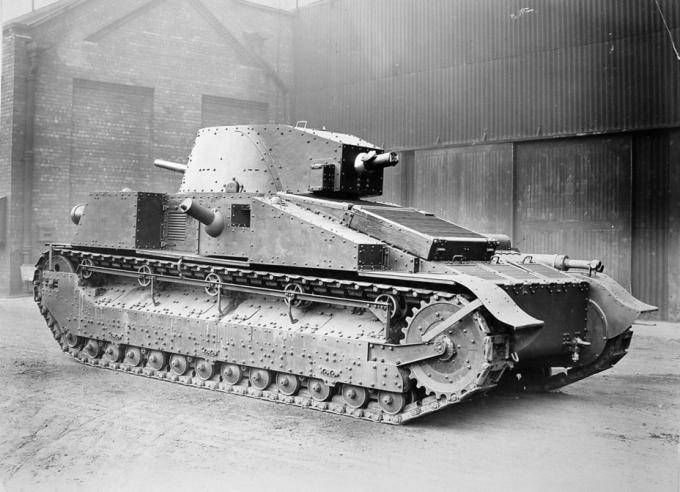
Medium Tank Mk.C with a turret machine gun facing back. And if you need to shoot forward with a machine gun, then you need to deploy the entire tower ...
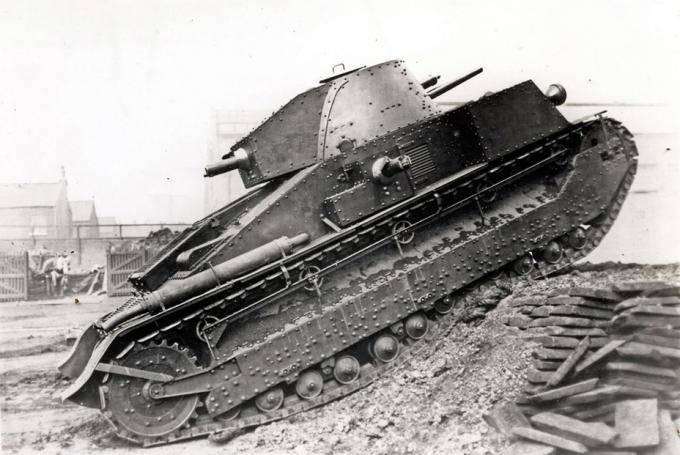
And he is on the go during trials
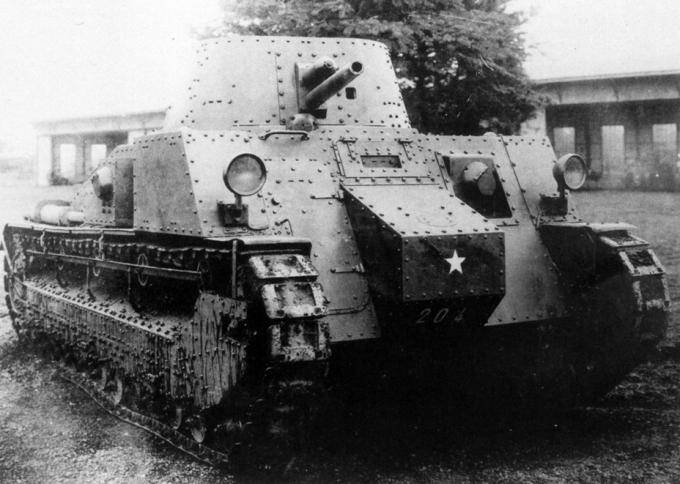
So he had such a funny "nose"
And so, on the basis of all this, the new Medium Tank Mk.C tank appeared, somewhat, let's say, of an unusual design. The front door is on the front right and left - the machine gun in the ball mount. 5 crew members who served 1 gun in the tower and 4 machine guns: two on the sides, one forward and another in the tower ... barrel back. Why it was not possible to pair it with a gun is completely incomprehensible. By the way, the legs of the driver, who was sitting in the center of the case, with this layout rested on the armor plate, and then in the center of the case they made a special multi-faceted ledge. Rejoiced at this tank, and almost immediately ... the Japanese! They bought it together with a production license in 1927 and released it under the name Type 89A Chiro, which subsequently changed the Type 89B Otsu sample.
The funny thing is that Japanese engineers with such reverence reacted to the British design, as if it were a sacred cow: they kept the door on the front armored plate of the case, and the installation of machine guns in the case and in the tower. In a word, they didn’t step back a single step from him.
The next model, the Medium Tank Mk.D, was bought by Ireland in 1929 and was used until 1940. But the gun removed from it was completely preserved to our time and is located in the training center of the Defense Forces of Ireland in Currach in the county of Kildare.
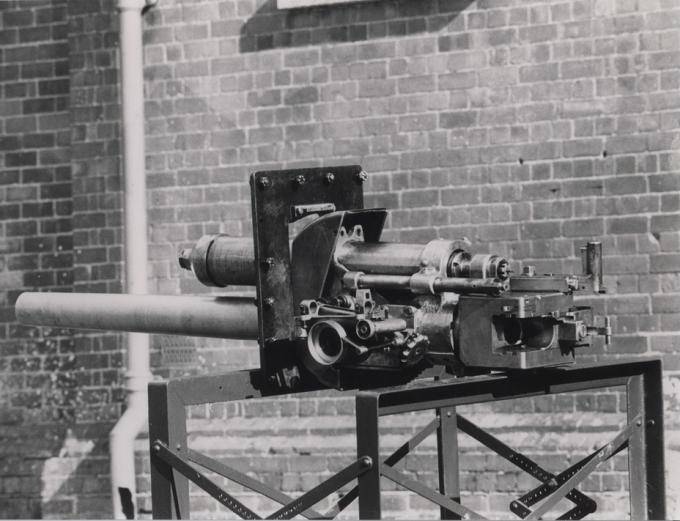
Here is the gun!
All these attempts, however, gave the military and engineers a certain experience, which the Royal Tank Corps in 1926 laid the foundation for new requirements for the development of a new medium tank. They finally abandoned the airborne machine guns, but the very idea of firing on board was recognized as correct. At the same time, the tank was to develop strong fire in the direction of movement. But this required at least three towers: two on the sides and one above them, so that if both towers were deployed to the sides, the central tower could shoot through the central sector, and, in general, fire at 360 degrees.
In this case, the combat weight had to be kept within 15,5 tons, since British military ferries did not raise more than 16 tons. The enemy tanks had to be hit at a distance of 900 meters (1000 yards). A radio station is a must, and fuel tanks should have been outside the hull. There was one more requirement: the tank should not have made too much noise.
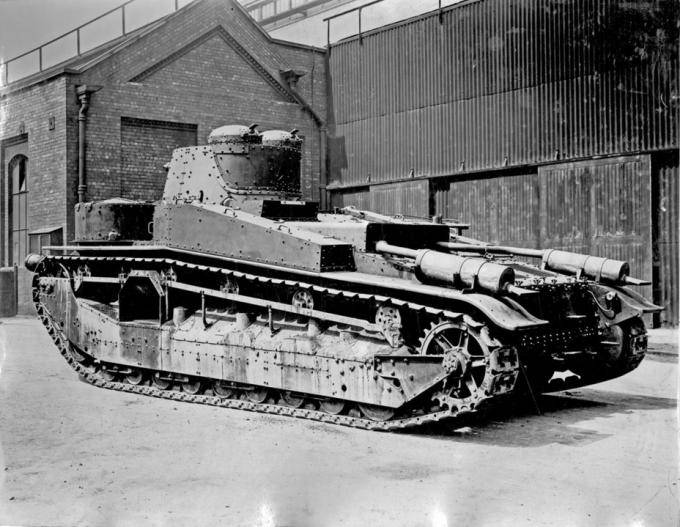
16-ton Vickers in the factory yard, 1927
Having experience with both the Medium Tank Mk.C and the A1E1 Independent, Vickers engineers had already prepared all design documentation for another tank by September 1926. Another "medium", that is, a medium tank, received the designation A6. With a planned weight of 14 tons, his reservation should have been 14 mm in the frontal and 9 mm in the side projections. Like the A1E1 Independent tank, the driver was seated in the center of the hull, in the wheelhouse, and machine-gun towers were placed on both sides of it. The main tower was armed with a 3-pound gun and coaxial machine gun. They quickly abandoned the anti-aircraft tower at the back, which provided a significant reserve of mass for strengthening the reservation.
The motor was installed in the rear of the hull. Moreover, two engines were offered: in 120 hp. (speed up to 22,4 km / h) and 180 hp with which he, having a specific power of more than 10 hp, could have a maximum speed of 32 km / h, which, of course, pleased the military.
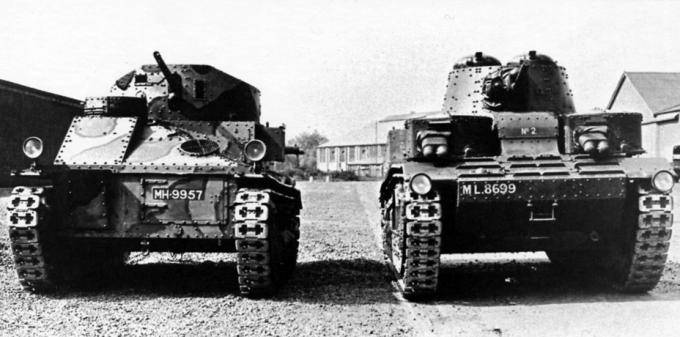
You can clearly see how the Medium Tank Mk.II and A6E2 differ from each other.
In the spring of 1927 a mock tank was made of wood. They looked at him and decided to build two tanks: A6E1 and A6E2. Both of them were equipped with a machine-gun train in machine-gun turrets, which greatly complicated the work of the shooters, although the firepower of the tank certainly increased greatly! And since the combat weight reached 16 tons, these machines began to be called the “16-tonner” (16-ton), and this unofficial name was fixed to it.
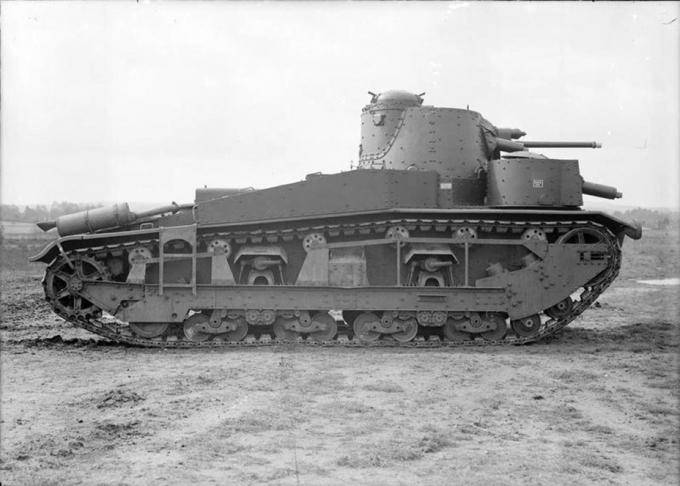
One of the A6 on the go during testing
The construction of the first tank, A6E1, which had a registration number T.404, was completed in early 1928. The tank externally copied a wooden mockup. The tank was very comfortable for the work of seven crew members. 416 liters of fuel, as the military wanted, was in the tanks outside the fighting compartment, where, however, they nevertheless put the tank at 37,5 liters in order to improve alignment. There were even two commander towers! But alas, there was no place for the radio station, since there was no feed niche on the tank.
Tank A6E2 with the number T.405 had a different transmission, but outwardly it did not differ from the first car. Therefore, they were often called 16-tonner No. 1 and 16-tonner No. 2.
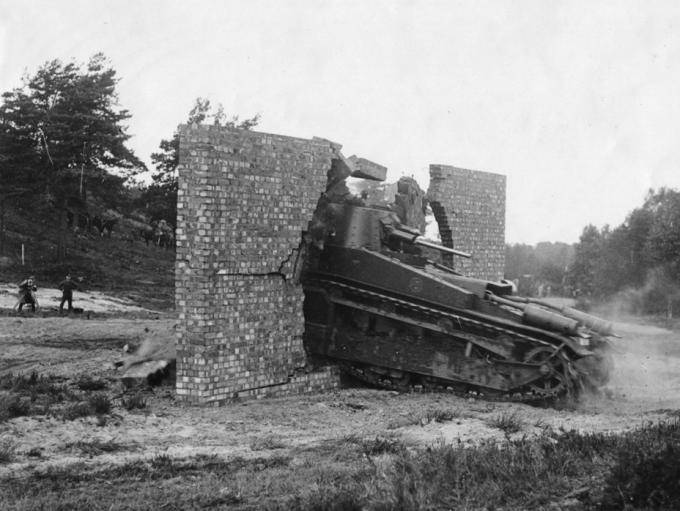
The tank goes through a brick wall!
In June 1928, both cars were sent to the Farnborough training ground. Where it turned out a curious fact. Even with a 120-horsepower engine, the tanks easily reached a speed of 41,5 km / h, although the suspension borrowed from the previous averages was clearly weak. It turned out at the shooting range that it was very difficult for the towers to control the machine gun pair, so they were left with one machine gun each.
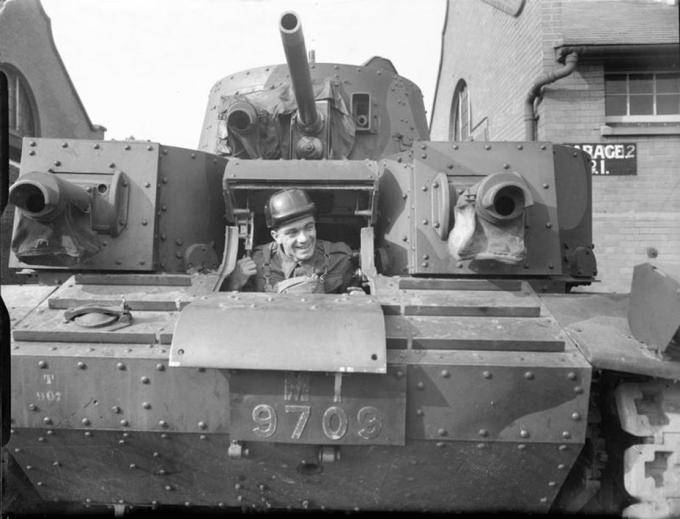
Tank A6E3. Well visible plate-bullets on the frontal armor of the hull
According to the tests, an improved version of the A6E3 tank with machine-gun turrets taken from the A1E1 Independent tank was designed. Their number was reduced to one, and also shifted to the right, so that inside they became more spacious. The commander’s turret was reduced to one.
The suspension was also improved by grouping the rollers into four groups, but this did not significantly improve it, but the mass of the tank increased and began to reach 16,25 tons. Whatever it was, but in 1928 an improved version of the A6 under the designation Medium Tank Mk.III came into service with the British army.
Keep in mind that Medium Tank Mk.III and A6 are often confused. Meanwhile, the Medium Tank Mk.III was not assigned an A6 index. Although these tanks were very similar and the weight of 16 tons was the same for them. The power plant was also the same. The length of the tank also has not changed, but its width has become slightly larger. With the A6E3 we got on a new machine and machine-gun turrets.
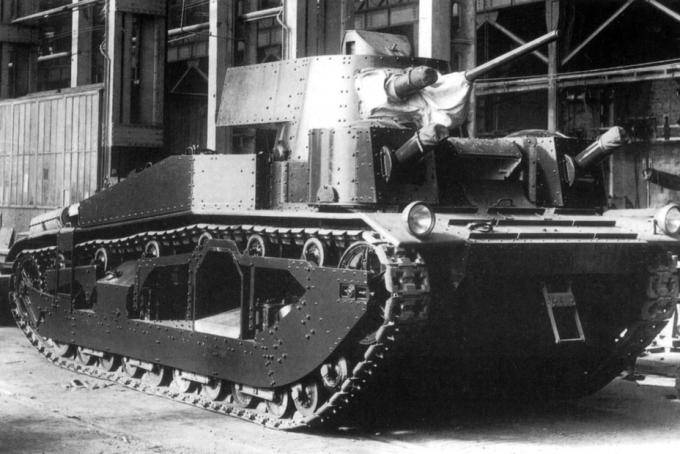
Medium Tank Mk.III in the factory workshop, 1929
The manufacture of the Medium Mk.III E1 and Medium Mk.III E2 was entrusted to the Royal Arsenal at Woolwich in 1929. They were assigned the numbers T.870 and T871. Since the radio station did not fit in the A6 conical tower, the main tower was now equipped with a well-developed aft niche, where the No. 9 radio station could be installed without problems. The commander’s turret was taken from the Medium Tank Mk.IIA.
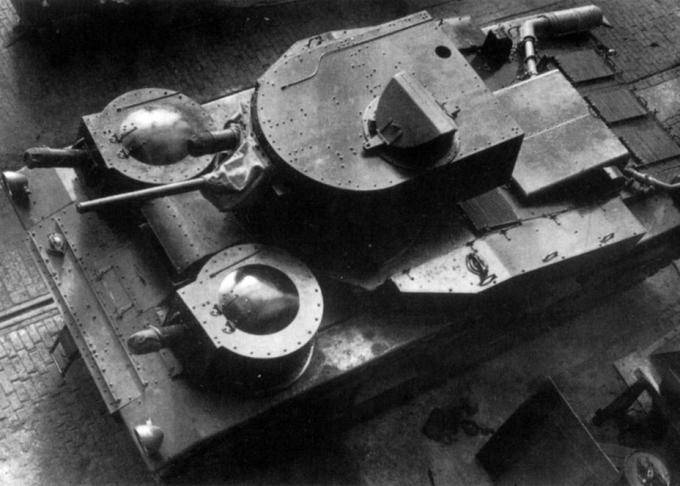
Medium Tank Mk.III. View from above. Hemispherical hatches of machine-gun towers and the new tower are clearly visible. The commander’s turret is one, such as the “bishop’s miter”
The tanks, as they say, “went”, began to take part in maneuvers - and here the economic crisis hit England. And since the fleet has always been a priority for the government of the country, the appetites of the tankers greatly curtailed.
Therefore, in 1931, the Vickers company built the last third Medium Tank Mk.III tank, and ... that’s all. This machine was no longer manufactured. And by 1934, it was already clear and more, namely, that the tank is becoming obsolete right before our eyes.
However, the tanks were actively operated until 1938. They took part in maneuvers, they were very fond of photographing by journalists from different countries of the world, which is why these tanks were multiplied tenfold. The tankers themselves highly appreciated their fighting qualities, and according to the level of ease of maintenance, according to them, these vehicles clearly exceeded their predecessors.
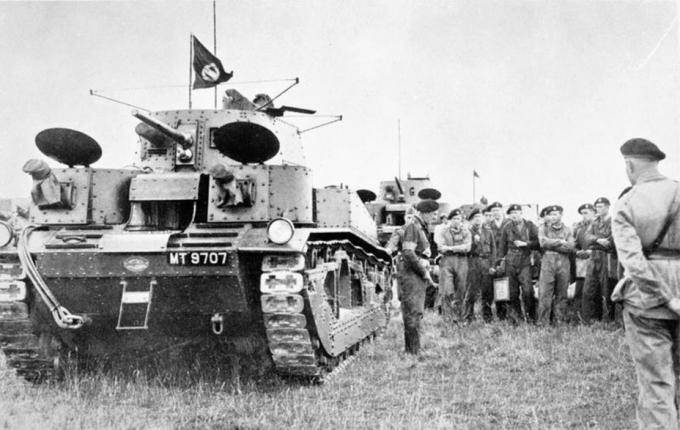
British "mediums" Mk.III on maneuvers
The Vickers 16 Ton did not go unnoticed in England itself and beyond. The British military liked the idea with two machine-gun turrets in front, and as a result, it soon migrated to the Vickers Mk.E Type A light tanks, and then the Cruiser Tank Mk.I and even the German heavy tank Nb.Fz.
But the biggest impact Medium Tank Mk.III had on Soviet tank building. In 1930, the Soviet purchasing commission headed by the head of the UMM, I. A. Khalepsky, arrived in Great Britain with the aim of purchasing promising tanks for production. The Vickers company presented to the Soviet delegation its entire typical set of export combat vehicles: a Carden-Loyd Mk.VI wedge, a Vickers Mk.E light tank and a medium Medium Tank Mk.II. And all of them were bought and adopted by us. Carden-Loyd Mk.VI became the T-27 wedge, and Mk.E "turned" into the T-26.
But the British did not show us the Medium Tank Mk.III. But engineer S. Ginzburg saw him and naturally began to ask about him. But this time we never got this tank. But on his second trip to England, Ginzburg managed to "talk" with everyone he could, and as a result he learned a lot about this tank. Then the British demanded 20 thousand pounds for familiarization with its technical documentation and another 16 thousand for each tank. But smart people often do not need to look at the drawings, as this letter speaks of:
As a result of my conversations with English instructors, the following information about the 16-ton Vickers tank was reported to me last.
The tank has already been tested and recognized as the best example of British tanks.
The overall dimensions of the tank are approximately equal to the dimensions of the 12-ton Vickers Mark II tank.
The maximum speed of 35 km (So in the text. - Approx. Aut.) Per hour.
Reservation: tower and vertical sheets of the fighting compartment 17-18 mm.
Armament: in the central tower - one "large" in the front side turrets - 1 machine gun. Total one gun and 2 machine guns.
Team: 2 officers (or one), 2 artillerymen, 2 machine gunners, 1 driver.
The 180 HP air-cooled motor has a start from an inertial starter and from an electric starter (the latter is a spare one). Start is made from inside the tank. Accessibility to the motor is good.
The pendant on each side has 7 candles with springs. Each candle rests on one of its own skating rink. Rollers are approximately six-ton devices. (I mean “Vickers 6-ton.” - Approx. Aut.) The suspension informs the stability of the tank as good as the six-ton tank.
Driving wheels back.
Small caterpillar with removable screwed spurs. Tracking and direction is like a six-ton tank.
The central tower has an optical sight and optical surveillance.
The driver's seat in the front in the middle provides good visibility for control.
Transmission - gearbox and side clutches. Gearbox of two types: original (patented) and normal type.
The radius of action is the same as that of a six-ton tank.
NOTE. Information was received only after the translator stated that we had already bought this tank and are awaiting its receipt.
Information was given: engineer mechanic-mechanic, senior master and the driver who conducted the tests of this machine. Information about the car is still classified.
APPENDIX: outline of the plan and side view of the tank.
CONCLUSION. Joining the conclusion of the instructors mentioned above that this vehicle is the best example of Andean tanks, I believe that this vehicle is of maximum interest to the Red Army as the best modern type of maneuverable medium tank.
As a result, the purchase of this machine is of invaluable interest. This machine will be released into the army units now or in the near future and, therefore, secrecy will be removed from it (as in the text. - Approx. Aut.).
The beginning of the Test. groups: / GINZBURG / ".
So those who say are very right: the talker is a godsend for the spy. But another proverb is true: the forbidden fruit is sweet! "Vickers 16-ton" in the arms of the British army in the end did not get, but the Red Army on the basis of its concept received a massive medium tank T-28!
Although it is incorrect to say that the T-28 was “from” and “to” copied from the Medium Tank Mk.III. Ginsburg, who was engaged in its development, took from the British machine only the very concept of a medium tank with a motor-transmission compartment in the stern and three towers in the bow, and a combat weight of about 16-17 tons. From a technical point of view, it was a completely different tank.
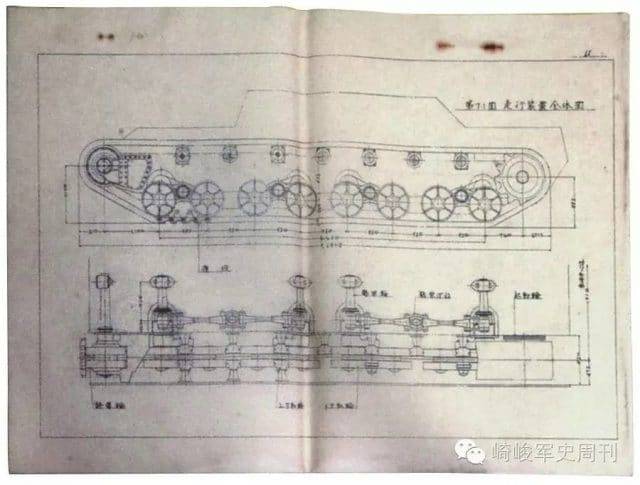
OI Tank Chassis
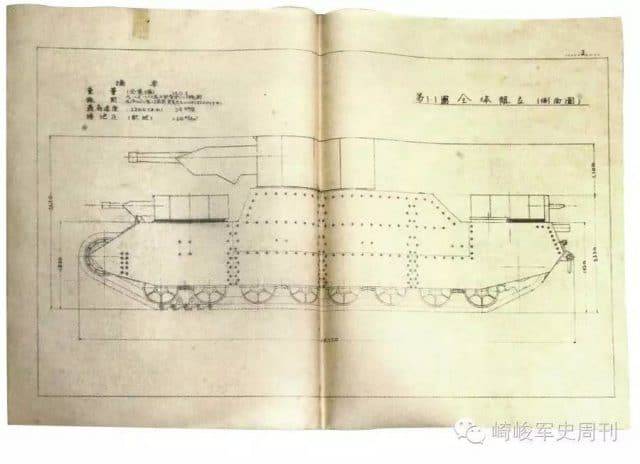
Side view
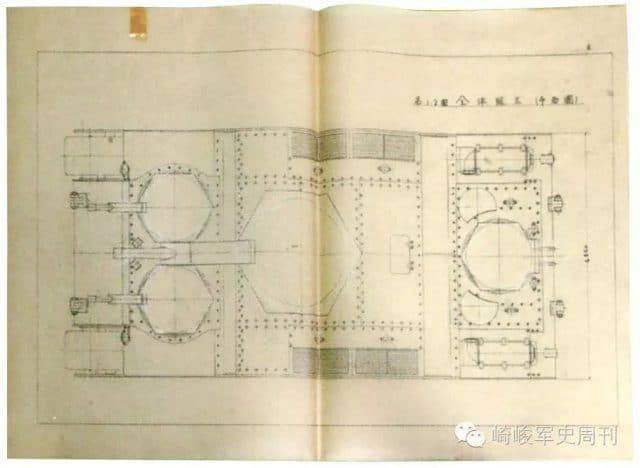
View from above
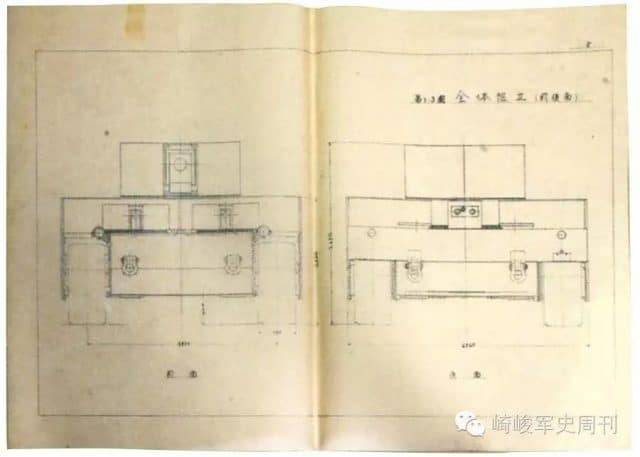
Front and back view
The idea of a two-tiered arrangement of tank weapons in the towers, besides us, was also taken up by the Japanese, who created a fleet of experimental three-tower vehicles similar to the Mk.III and T-28. The most powerful among them was to become the 100-ton OI super tank, which had three turrets with guns and one (aft) with a machine gun. Guns - 105 and 47 mm. Armor: 200 mm at the front, 150 at the rear and 75 at the sides. But due to a lack of production capacity, they were able to build only one prototype from non-armored steel and without towers, and that in 1944 was dismantled for metal.
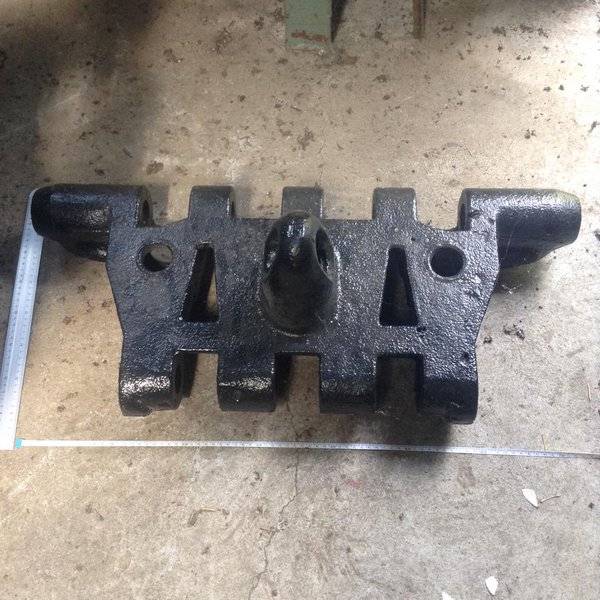
OI tank tracks are now on display at Japan's Tagihara Self Defense Forces camp
On this the story of the English "mediums" is completely over!
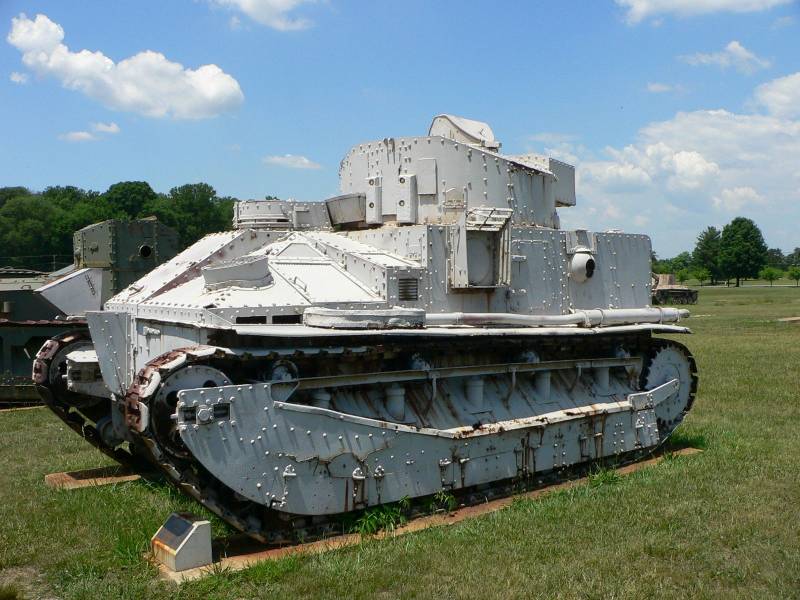
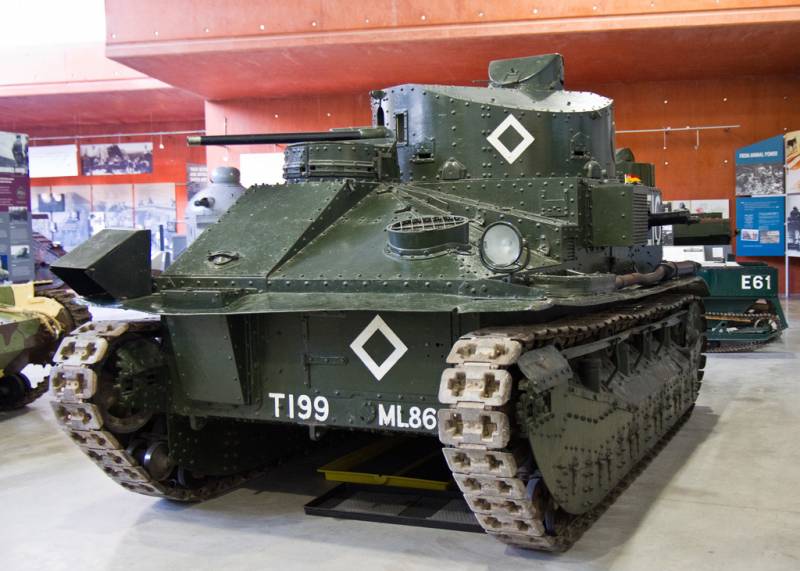
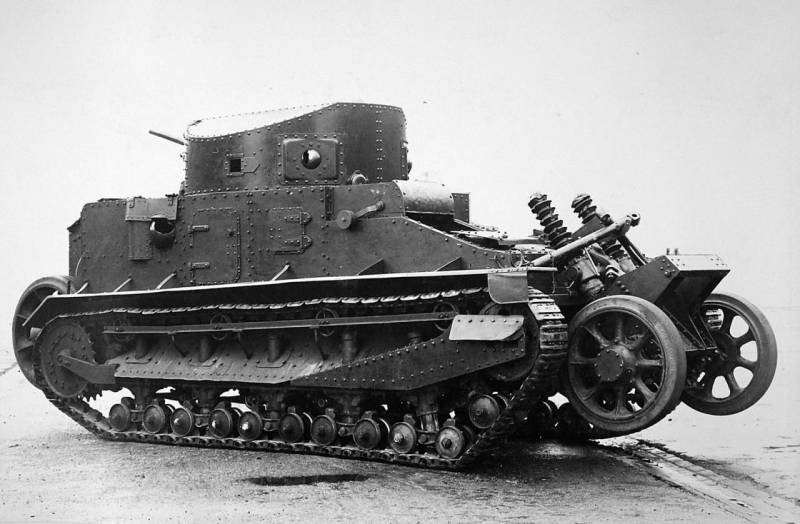
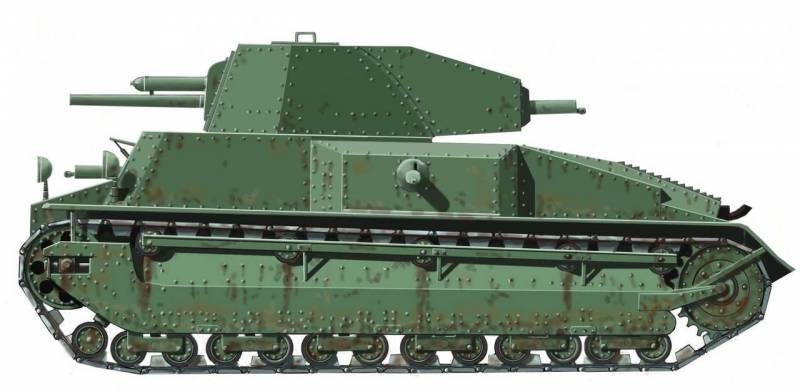
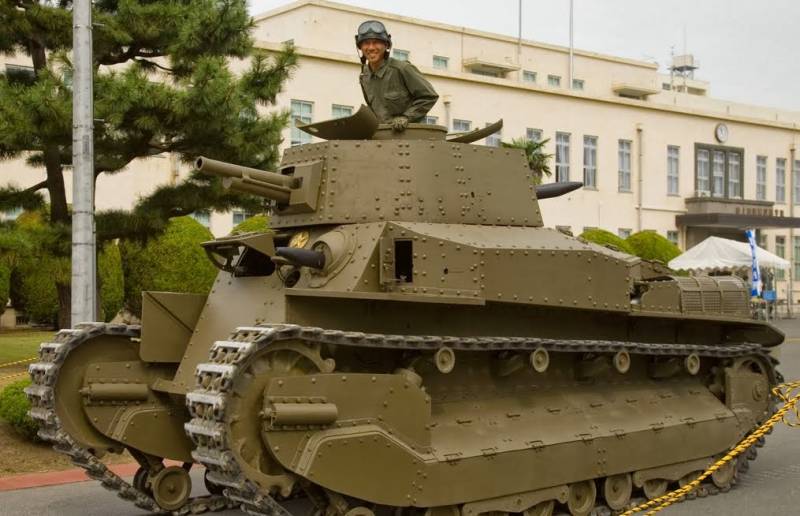
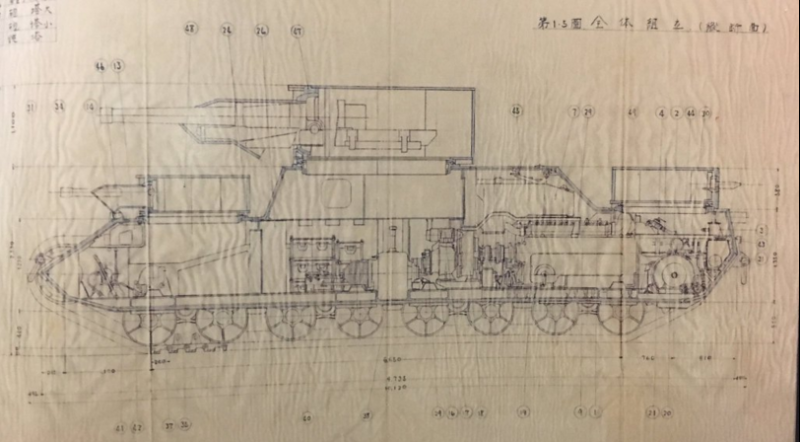
Information